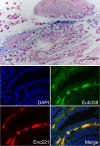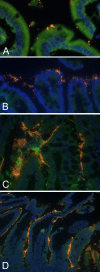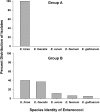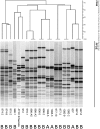Mortality in kittens is associated with a shift in ileum mucosa-associated enterococci from Enterococcus hirae to biofilm-forming Enterococcus faecalis and adherent Escherichia coli
- PMID: 23966487
- PMCID: PMC3889735
- DOI: 10.1128/JCM.00481-13
Mortality in kittens is associated with a shift in ileum mucosa-associated enterococci from Enterococcus hirae to biofilm-forming Enterococcus faecalis and adherent Escherichia coli
Abstract
Approximately 15% of foster kittens die before 8 weeks of age, with most of these kittens demonstrating clinical signs or postmortem evidence of enteritis. While a specific cause of enteritis is not determined in most cases, these kittens are often empirically administered probiotics that contain enterococci. The enterococci are members of the commensal intestinal microbiota but also can function as opportunistic pathogens. Given the complicated role of enterococci in health and disease, it would be valuable to better understand what constitutes a "healthy" enterococcal community in these kittens and how this microbiota is impacted by severe illness. In this study, we characterized the ileum mucosa-associated enterococcal community of 50 apparently healthy and 50 terminally ill foster kittens. In healthy kittens, Enterococcus hirae was the most common species of ileum mucosa-associated enterococci and was often observed to adhere extensively to the small intestinal epithelium. These E. hirae isolates generally lacked virulence traits. In contrast, non-E. hirae enterococci, notably Enterococcus faecalis, were more commonly isolated from the ileum mucosa of kittens with terminal illness. Isolates of E. faecalis had numerous virulence traits and multiple antimicrobial resistances. Moreover, the attachment of Escherichia coli to the intestinal epithelium was significantly associated with terminal illness and was not observed in any kitten with adherent E. hirae. These findings identify a significant difference in the species of enterococci cultured from the ileum mucosa of kittens with terminal illness compared to the species cultured from healthy kittens. In contrast to prior case studies that associated enteroadherent E. hirae with diarrhea in young animals, these controlled studies identified E. hirae as more often isolated from healthy kittens and adherence of E. hirae as more common and extensive in healthy kittens than in sick kittens.
Figures








Similar articles
-
In situ molecular diagnosis and histopathological characterization of enteroadherent Enterococcus hirae infection in pre-weaning-age kittens.J Clin Microbiol. 2010 Aug;48(8):2814-20. doi: 10.1128/JCM.00916-09. Epub 2010 Jun 2. J Clin Microbiol. 2010. PMID: 20519483 Free PMC article.
-
Randomized placebo-controlled trial of feline-origin Enterococcus hirae probiotic effects on preventative health and fecal microbiota composition of fostered shelter kittens.Front Vet Sci. 2022 Nov 17;9:923792. doi: 10.3389/fvets.2022.923792. eCollection 2022. Front Vet Sci. 2022. PMID: 36467638 Free PMC article.
-
The effect of enterococci on feline Tritrichomonas foetus infection in vitro.Vet Parasitol. 2019 Sep;273:90-96. doi: 10.1016/j.vetpar.2019.08.012. Epub 2019 Aug 20. Vet Parasitol. 2019. PMID: 31454711
-
Risks associated with enterococci as probiotics.Food Res Int. 2020 Mar;129:108788. doi: 10.1016/j.foodres.2019.108788. Epub 2019 Nov 21. Food Res Int. 2020. PMID: 32036912 Review.
-
[Pathogenicity of Enterococci].Nihon Saikingaku Zasshi. 2017;72(2):189-211. doi: 10.3412/jsb.72.189. Nihon Saikingaku Zasshi. 2017. PMID: 28659548 Review. Japanese.
Cited by
-
Interventions and observations associated with survival of orphaned shelter kittens undergoing treatment for diarrhea.J Feline Med Surg. 2020 Apr;22(4):292-298. doi: 10.1177/1098612X19840459. Epub 2019 Mar 28. J Feline Med Surg. 2020. PMID: 30920335 Free PMC article.
-
Comparison of Enterococcus faecalis Biofilm Removal Efficiency among Bacteriophage PBEF129, Its Endolysin, and Cefotaxime.Viruses. 2021 Mar 7;13(3):426. doi: 10.3390/v13030426. Viruses. 2021. PMID: 33800040 Free PMC article.
-
Gallbladder microbiota in healthy dogs and dogs with mucocele formation.PLoS One. 2023 Feb 10;18(2):e0281432. doi: 10.1371/journal.pone.0281432. eCollection 2023. PLoS One. 2023. PMID: 36763596 Free PMC article.
-
Comparative Genomics of Atypical Enteropathogenic Escherichia coli from Kittens and Children Identifies Bacterial Factors Associated with Virulence in Kittens.Infect Immun. 2021 Feb 16;89(3):e00619-20. doi: 10.1128/IAI.00619-20. Print 2021 Feb 16. Infect Immun. 2021. PMID: 33257534 Free PMC article.
-
Efficacy of probiotic, prebiotic, synbiotic and postbiotic supplementation on gastrointestinal health in cats: systematic review and meta-analysis.J Small Anim Pract. 2025 Apr;66(4):219-235. doi: 10.1111/jsap.13822. Epub 2025 Jan 12. J Small Anim Pract. 2025. PMID: 39800337 Free PMC article.
References
-
- American Veterinary Medical Association 2012. Overview: total pet ownership and pet population, p 31–32 In U.S. pet ownership and demographics sourcebook, section 1. American Veterinary Medical Association, Schaumburg, IL
-
- Scott FW, Geissinger C. 1978. Kitten mortality survey. Fel. Pract. 8:31–34
-
- Nutter FB, Levine JF, Stoskopf MK. 2004. Reproductive capacity of free-roaming domestic cats and kitten survival rate. J. Am. Vet. Med. Assoc. 225:1399–1402 - PubMed
-
- Young C. 1973. Preweaning mortality in specific pathogen-free kittens. J. Small Anim. Pract. 14:391–397 - PubMed
Publication types
MeSH terms
LinkOut - more resources
Full Text Sources
Other Literature Sources
Molecular Biology Databases

